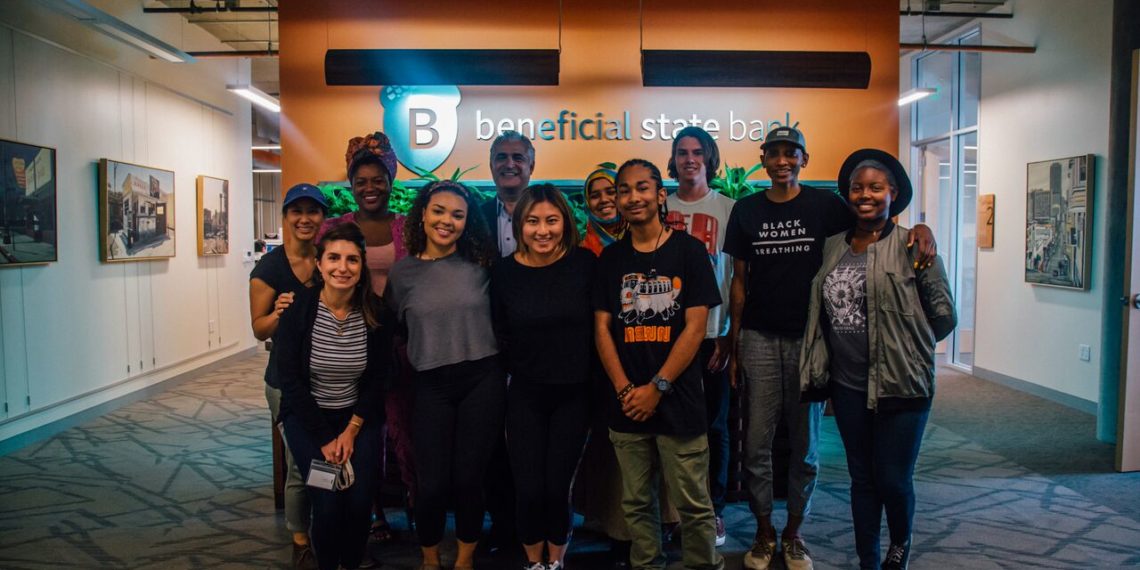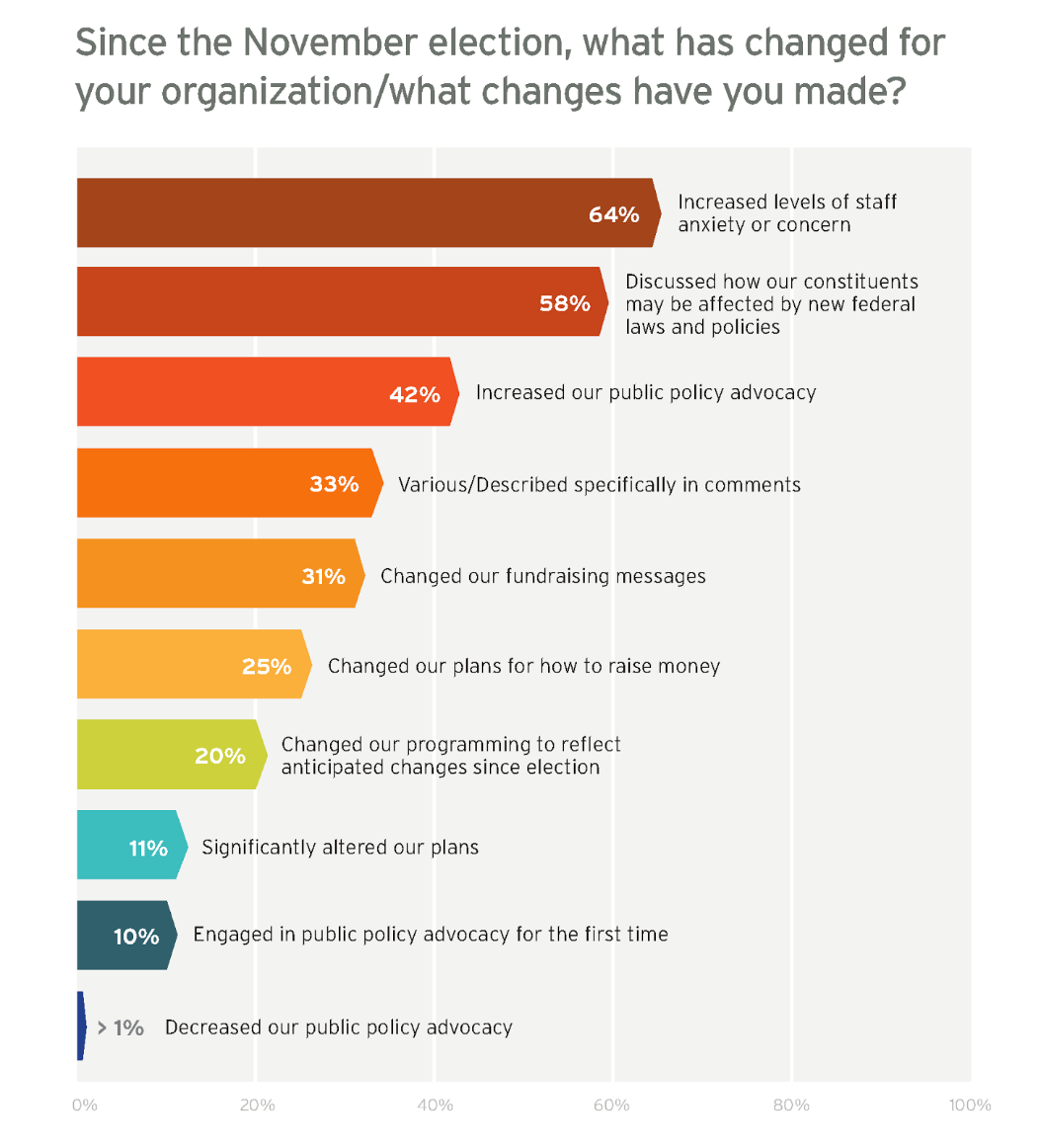Beyond one-day service: how you and your company can build lasting relationships with nonprofits to further your mission

In order to build a new economy that’s inclusive of all communities and sustainable for the planet, the business and nonprofit sectors must team up and build new systems together. As a Beneficial State Foundation Fellow, my focus was to lead market research on the nonprofit sector, including conducting interviews with thirteen nonprofit leaders throughout California, Oregon and Washington. This blog explores a few challenges I identified through these interviews, and some suggestions for how individuals and business leaders can be better partners to nonprofits.
As an MBA candidate at Presidio Graduate School studying triple-bottom-line business and social entrepreneurship, I deeply believe in the power that business can have in catalyzing systems change with thoughtful consideration for its stakeholders. Despite the progress the business sector has made towards becoming more sustainable, we still have mountains of work ahead of us. Let’s face it: big, gnarly, societal problems will always persist in various forms. As one of my wise professors likes to say, “As soon as you have the answers, the questions change.”
“The most critical work that needs to be done is what I call high impact, low profile work.” – Jan Masaoka, CEO, CalNonprofits
The nonprofit sector is critical for addressing these problems with its reach across interconnected spectrums of society. Nonprofits play the important role of think tanks who lead formative research, build pilot programs, and catalyze movements. On the other side, nonprofits can also act as last line of defense, serving those who have been failed by inequitable systems in our society. And while the business pendulum is beginning to shift in a more responsible direction, nonprofits are often the invisible glue, binding communities. In an era where various public sector players are failing to meet basic needs for some of our population, the role of nonprofits is more important than ever before.
CHALLENGE: Capacity Building
The greatest capacity building challenge that nonprofits face is a shortage of staff and talent. In one interview, an Executive Director revealed: “The dark side or shadow to nonprofits is that they compete for talent. The sector has a challenging time sourcing professionals because the pay isn’t competitive. And there’s a lot of turnover between like organizations.”
In learning about the talent shortage, I thought that this was yet another reason why volunteering plays such an important role. While this may be true, I discovered that volunteering can also be problematic. In fact, multiple interviewees expressed that one-time volunteering habits are often something nonprofits “endured.” Yikes!
Interviewees expressed that when it comes to Board of Director positions, board members can be harmful when they apply the exact same principles and strategy of their own businesses to the nonprofit they’re serving on. Instead, the organization should be treated as a unique entity with different resources, operations, and purpose.
Nonprofit leadership can also create problems with board service. While on a mission to find a board member to a) amplify their mission and b) fulfill legal requirements, it’s not uncommon to lure business leaders into serving on a board under false pretenses. Often they’ll frame the opportunity as one that “won’t be that much work!” The fib that board service is a small undertaking is hugely destructive to organizations and their potential. In doing this, nonprofits automatically diminish the huge responsibility it is to serve on a board. If you’re a current or future board member, be ready and willing for a significant commitment.
SOLUTION!
- Update your company’s volunteer hours strategy to encourage long-term service & formal partnership capacities. Some companies are known to compensate employees’ time for up to 40 hours / year.
- As a volunteer, ditch any thinking that you might “know what’s best” for the nonprofits you’re serving.
- Consider how your business can count civic engagement as volunteerism. How is it defined in your policy?
- Like many behavioral patterns, there’s a gap between people wanting to volunteer and actually doing it. If you must, address stagnant volunteerism at your company by organizing a group outing where people can volunteer together. Making it a regular habit will hopefully outweigh any drain it might have on a nonprofit.
“Nonprofits are at the forefront of understanding and addressing social and economic disparities.” – Nonprofit Association of Oregon
CHALLENGE: Nonprofit Displacement
The second greatest capacity building challenge nonprofits face is lack of space and equipment. Nonprofits in urban areas are increasingly being forced to move, or combine offices with two to three other organizations due to rising rents. Why not purchase a building? It’s challenging for nonprofits skating by on their annual budget to set aside savings towards a down payment towards a building purchase. Oftentimes, the majority of nonprofits (who are under $100,000 in annual revenues) don’t have not any collateral to begin with. The cycle of nonprofit displacement is a real issue that’s costly, and exacerbates stress and employee turnover.
SOLUTION!
- If your company’s based in an urban area with rising rents, consider renting space or equipment to a nonprofit at a more affordable rate.
CHALLENGE: Equity Work
Equity can be roughly defined as allocating money and systemic support to the communities who have been marginalized and systematically discriminated against to level the playing field for all. Vu Le, a comedic nonprofit thought leader and the Executive Director of Rainier Valley Corps defines equity on his popular blog here.
It’s not news that oftentimes communities with the highest need get the least attention and least financial support. Many foundations and funders have been shifting funding practices towards using “an equity lens”. However, according to one nonprofit consultant interviewed, despite this focus, equity isn’t getting better, it’s getting worse. She wasn’t alone in this unsettling sentiment.
In trying to do good things for, rather than with, marginalized communities, there are still very harmful practices that halt progress. Effective community engagement with marginalized communities is often missing, or is treated as an afterthought. This only reinforces cycles of inequity. Oftentimes businesses want to turn their attention to the shiny, trending objects, rather than embracing the lower profile work that may be most impactful to communities.
SOLUTION!
- Hire a consultant and host a diversity and social justice training (or ongoing trainings) with employees to deepen awareness of inherent bias and systems that may be failing or harming your stakeholders. And create a permanent committee within the company who will keep social justice issues at the forefront of company decision-making.
- Consider setting aside funds for rapid responses needed in the community.
- Focus on specific communities and not just hot-button issues. People feel the most significant impacts when they’re tangible and targeted for specific community needs.
- Inequity is incredibly complex and will require many different solutions. Keep in mind that these solutions will require a whole lot of trying, failing, and learning along the way.
CHALLENGE: Funding Cuts & Policy Reform

Perhaps the largest trend affecting the behavior and well-being of nonprofits today is the current political climate. The chart below illustrates responses from 800 nonprofits in a CalNonprofits survey taken in March of 2017. With federal budget cuts to human services, the environment, the arts—and more organizations need to face the reality and quickly adapt to current and imminent funding disruptions.
What many people don’t realize is that much of this funding is invisible to the general public and it’ll likely have a domino effect.
What happens when government funding disappears? Nonprofits will scale back from innovation to providing basic services in times of economic stress. For example, the health and wellness program for a low-income population will be reduced to a simple food program. This shatters the holistic desired outcomes that these organizations and their funders envisioned. In addition to shrinking services, there’s always a chance that people will be laid off or that the organization will close its doors.
For policy affecting nonprofits, and well, everyone. . . The Johnson Amendment will be eliminated by Congress and the Trump Administration through the latest tax bill. This enables nonprofit and religious organizations (who are exempt from taxation) to legally endorse political candidates, having serious implications for campaign finance. Boiled down, the repeal of The Johnson Amendment eliminates nonpartisan regulations in place for tax-exempt institutions.
SOLUTION!
- Show up for nonprofit stakeholders on policy positions. Make endorsements and be vocal advocates for issues aligned with your values. Attend community events and forums, hang signs, wear buttons, write an op-ed, start a flash dance mob.

Mike Torres (Opportunity Fund), Sarah Livnat (Opportun) and Beneficial State Foundation’s Director of Strategic Communications Emma Guttman-Slater meet with Congresswoman Roybal-Allard to share the importance of the CDFI Fund.
- As an organization’s financial capacity grows, it’s typically more effective in accomplishing its mission. Donate a portion of your profits to nonprofits. Stumped on who to support? Utilize resources like Willamette Week’s Give!Guide, an annual guide to giving in Portland, OR. Note that California nonprofits receive roughly 8% of their revenues from individual donors. So even if individual giving has increased to 10%, it will likely not make up for the loss of funding. This is yet another reason why it’s critical to donate money as a member of the business community. If funds are tight, consider donating to smaller nonprofits where your money could make a more significant local impact.
- Further the missions of your favorite nonprofits by simply moving your money into banks, credit unions, and retirement funds that align with these missions. While your money sleeps at night, it has the potential to help advance those causes. You can even take steps to convince your employer to shift your company’s retirement plans. Here are some resources to get a move on it:
- Global Alliance for Banking on Values – bank with a member!
- HIP Investor – evaluates sustainable investments and 401K plans with human impact + profit
- Blooom – affordable online 401K money management for the 99%
- Check out the Fossil Free Fund / Tobacco Free Fund, projects from As You Sow
- Arjuna Capital – sustainable investment management
A special thank you to the talented nonprofit community who generously shared their time, ideas, insights, and expertise!
Nonprofit Sector Resources:
- Nonprofit Association of Oregon (NAO)
- CalNonprofits
- Washington Nonprofits
- National Council of Nonprofits
- Affordable Housing And Sustainable Communities Program: California Strategic Growth Council
- Nonprofit Hour Podcast
- NonprofitAF
- The Impact Foundry
- Blue Avocado
Tegan participated in Beneficial State Foundation’s 2017 Summer Fellowship as the Community Engagement Fellow based in Portland, OR.
This blog post reflects the author’s personal views and opinions, and does not represent the views and opinions of Beneficial State Bank and/or Beneficial State Foundation.


